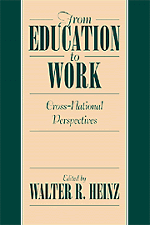Book contents
- Frontmatter
- Contents
- Contributing Authors
- Preface
- Introduction: Transitions to Employment in a Cross-National Perspective
- Part I Social Origin, Gender, and Transition Patterns
- Part II Education and Labour Markets: Work Experiences, Skills, and Credentials
- 5 Adolescent Part-Time Work and Postsecondary Transition Pathways in the United States
- 6 Multiple Life-Sphere Participation by Young Adults
- 7 The Subbaccalaureate Labor Market in the United States: Challenges for the School-to-Work Transition
- 8 Creating New Pathways to Adulthood by Adapting German Apprenticeship in the United States
- 9 Job-Entry Patterns in a Life-Course Perspective
- Part III Changes in the Social Context of Transitions
- References
- Index
9 - Job-Entry Patterns in a Life-Course Perspective
Published online by Cambridge University Press: 30 September 2009
- Frontmatter
- Contents
- Contributing Authors
- Preface
- Introduction: Transitions to Employment in a Cross-National Perspective
- Part I Social Origin, Gender, and Transition Patterns
- Part II Education and Labour Markets: Work Experiences, Skills, and Credentials
- 5 Adolescent Part-Time Work and Postsecondary Transition Pathways in the United States
- 6 Multiple Life-Sphere Participation by Young Adults
- 7 The Subbaccalaureate Labor Market in the United States: Challenges for the School-to-Work Transition
- 8 Creating New Pathways to Adulthood by Adapting German Apprenticeship in the United States
- 9 Job-Entry Patterns in a Life-Course Perspective
- Part III Changes in the Social Context of Transitions
- References
- Index
Summary
In all industrial service societies, there is a growing concern about the social and economic future of the young generation. With increasing unemployment and protracted and uncertain transitions from school to work, the linkages between education and employment have become decoupled. This is occurring even in Germany, which has been known for its well-structured school-to-work transition system.
Our longitudinal research sheds light on the employment chances and risks connected with job entry in occupations that require vocational training (but not academic education) in Germany in the 1990s. We also analyze the modes of biographical orientation and action young skilled workers develop in the course of this transition. As a conceptual framework, we suggest combining the notions of structure and agency (Giddens, 1984) with a life-course perspective (Elder & O'Rand, 1995; Heinz, 1991). Such a framework focuses not only on the effects of opportunities and constraints that structure job entry and careers but also on the interrelationships among occupations, work experiences, and individual decisions between alternative transition pathways. Although research on careers and social mobility looks primarily at structural (labor markets) and organizational (company politics) forces, our study asked how young people transform their social origin, gender, and education into occupational choices and careers.
- Type
- Chapter
- Information
- From Education to WorkCross National Perspectives, pp. 214 - 232Publisher: Cambridge University PressPrint publication year: 1999
- 19
- Cited by



